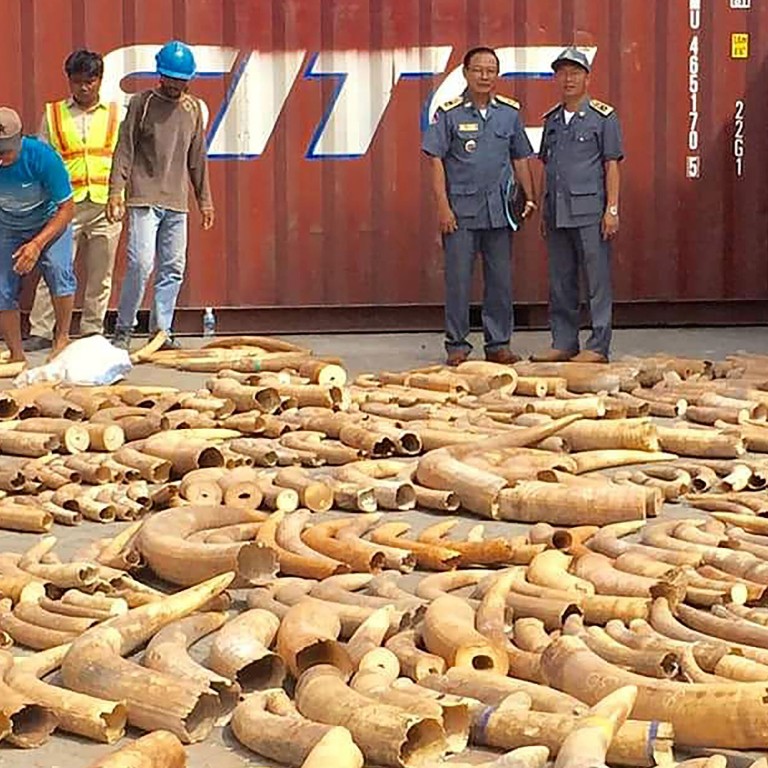
After ivory trade crackdown, Chinese buyers find new black market in Cambodia
- China’s ban in 2017 caused a fall in demand but elsewhere in Asia countries with weak policing draw new traders and tactics, say animal activists
- The Covid-19 pandemic has put greater scrutiny on the wildlife trade
But tightening regulations and enforcement have not stamped out the trade in Asia. Instead it has forced criminal networks to adapt and shift to countries less able to enforce the tough rules, according to a new investigation into the illegal ivory trade in Cambodia.
“Increased law enforcement action by China and neighbouring countries, such as Vietnam and [Laos], has resulted in a visible reduction of the open sale of ivory,” said Sarah Stoner, director of intelligence at The Hague-based WJC.
“Inevitably, crime has gone underground and is resurfacing in countries with less law enforcement capacity to tackle wildlife crime, such as Cambodia.”
Ivory was found to be moving into the country overland from Thailand, Laos and Vietnam, where it could either be sold or processed for retail sale in Sihanoukville and Phnom Penh, major hubs for Chinese travellers. China is the largest source of visitors to Cambodia.
In one case, a wood processing factory in Phnom Penh was found to be a cover for a mass ivory processing operation, using automated machinery to make ivory jewellery. The discovery, made during the WJC investigation, led to a Chinese national being charged in spring for wildlife offences, the commission said.
“We know in the past there’s been seizures of ivory being smuggled into Cambodia, but in terms of being a hub for processing ivory, this is not something that we knew or suspected previously,” Stoner said.
She said previous research had identified a retail market in Cambodia, where such trade was illegal. Stoner and her team linked their findings showing ivory was being processed inside the country to tightening regulations and enforcement elsewhere in the region.
Maasai warrior hopes to see end to Chinese obsession with rhino horn, ivory
China banned the domestic trade and processing of ivory at the end of 2017. Chinese consumers had been leading drivers of the global trade and the ban had a significant impact, according to wildlife trafficking monitoring groups.
Declines in both demand and the price of ivory have been documented following China’s domestic ban. Meanwhile, high-profile border seizures and busts of smugglers have put the spotlight on international ivory trafficking. Commercial international ivory trading has been banned since 1989 under the Convention on International Trade in Endangered Species of Wild Fauna and Flora.
A 2019 survey by the WWF conducted in 15 Chinese cities found people reported buying much less ivory than before China’s ban, with nearly 80 per cent of the 2,000 respondents saying the ban would stop them buying ivory in future.
But there was one exception to the downward trend. There was a rise in buying among travellers, with overseas buying rising overall – from 18 per cent in 2018 to 27 per cent of travellers in 2019.
That was the dynamic at play in Cambodia, Stoner said, adding that much of the trade the WJC detected involved processed ivory and trinkets, which buyers were encouraged to carry home in their luggage.
Signs that the ivory trade had shifted to Cambodia were “unsurprising”, according to Amanda Whitfort, an associate professor at the University of Hong Kong’s law faculty specialising in animal welfare law.
She pointed to previous studies indicating Cambodia, Laos and Myanmar as “rising hotspots” for wildlife trade tourism, but said regulations alone could not stamp out an evolving criminal trade in the region, where Chinese buyers had shown to be significant drivers.
“A ban on domestic ivory sales in China cannot destroy demand without parallel education and enforcement,” she said.
Delight and dismay at elephant trade ban
But Stoner said the Covid-19 pandemic, which had made travel more difficult and more heavily monitored, was an opportunity for law enforcement agencies to increase their efforts. The global health crisis had also underlined the importance of being able to monitor the wildlife trade, which was thought to have caused the outbreak.
“There needs to be a regional level response to this problem,” she said.

